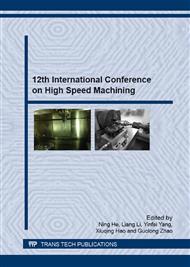p.215
p.220
p.228
p.234
p.242
p.250
p.256
p.263
p.270
Diffusion Wear and Oxidation Wear of PCBN Tool when Cutting Materials Difficult-to-Cut Based on Thermodynamics Solubility
Abstract:
Cutting temperature always highly reaches over to 1000°C when high speed machining with PCBN tools. Diffusion of tool material element may have important influence on tool wear at such high temperature., the diffusion wear and oxidation wear have become the major wear mechanism. In this paper, the rules of diffusion wear and oxidation wear for PCBN cutting tools are proposed and analyzed based on thermodynamics theory. Dissolution concentrations in typical normal workpice materials of PCBN tool material at different temperature are then calculated. Diffusion reaction rules in high temperature are developed and analyzed using Gibbs free energy criterion. The machining tests were conducted using the PCBN tools at different cutting speeds of 50, 95,100 and 180 m/min, feed of 0.1, 0.2mm and depth of cut of 0.1, 0.8, 1, and 1.5 mm respectively on PUMA300LM numerically-controlled lathe. It was found that the theoretical results were uniform with the experimental data; the results will provide useful references for tool material design and selection.
Info:
Periodical:
Pages:
242-249
Citation:
Online since:
January 2016
Authors:
Keywords:
Price:
Сopyright:
© 2016 Trans Tech Publications Ltd. All Rights Reserved
Share:
Citation:


